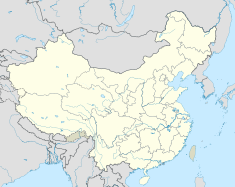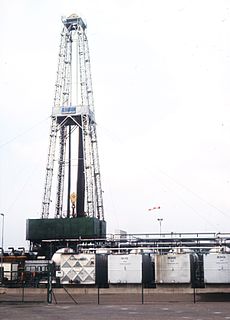
Hydrocarbon exploration is the search by petroleum geologists and geophysicists for deposits of hydrocarbons, particularly petroleum and natural gas, in the Earth using petroleum geology.
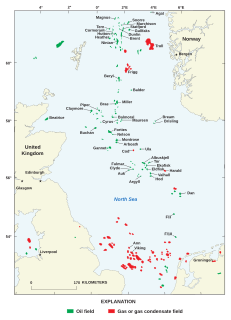
North Sea oil is a mixture of hydrocarbons, comprising liquid petroleum and natural gas, produced from petroleum reservoirs beneath the North Sea.
The Tangguh gas field is a gas field lies in Berau Gulf and Bintuni Bay, in the province of West Papua, Indonesia. The natural gas field contains over 500 billion cubic metres of proven natural gas reserves, with estimates of potential reserves reaching over 800 billion cubic metres.

The China National Petroleum Corporation (CNPC) is a major national oil and gas corporation of China and one of the largest integrated energy groups in the world. Its headquarters are in Dongcheng District, Beijing. CNPC was ranked fourth in 2020 Fortune Global 500, a global ranking of the largest corporations by revenue.
China Oilfield Services (COSL) is an oilfield services company. It is a majority owned subsidiary of Chinese state owned company CNOOC Group. It also has a listed sister company in Hong Kong, CNOOC Limited.

A petroleum reservoir or oil and gas reservoir is a subsurface accumulation of hydrocarbons contained in porous or fractured rock formations.

Pharos Energy Plc, previously SOCO International, is an oil and gas exploration and production company, headquartered in London. The company changed its name to Pharos Energy Plc in October 2019 after coming under fire for illegal activity in Virunga.

The Sirte Basin is a late Mesozoic and Cenozoic triple junction continental rift along northern Africa that was initiated during the late Jurassic Period. It borders a relatively stable Paleozoic craton and cratonic sag basins along its southern margins. The province extends offshore into the Mediterranean Sea, with the northern boundary drawn at the 2,000 meter (m) bathymetric contour. It borders in the north on the Gulf of Sidra and extends south into northern Chad.

The petroleum industry of Ghana is regulated by the state-owned Ghana National Petroleum Corporation (GNPC) and administered by the state-owned Ghana Oil Company (GOIL).

The impact of the petroleum industry has been increasing globally as China ranks seventh for oil production and second in crude oil consumption in the world.
In 2006, Cambodia's mineral resources remained, to a large extent, unexplored. Between 2003 and 2006, however, foreign investors from Australia, China, South Korea, Thailand, and the United States began to express their interest in Cambodia's potential for offshore oil and gas as well as such land-based metallic minerals as bauxite, copper, gold, and iron ore, and such industrial minerals as gemstones and limestone.
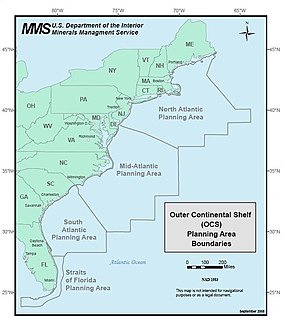
Offshore drilling for oil and gas on the Atlantic coast of the United States took place from 1947 to the early 1980s. Oil companies drilled five wells in Atlantic Florida state waters and 51 exploratory wells on federal leases on the outer continental shelf of the Atlantic coast. None of the wells were completed as producing wells. All the leases have now reverted to the government.

Crescent Petroleum is the first and largest private upstream oil and gas company in the Middle East. Founded in 1971, Crescent Petroleum is headquartered in the Emirate of Sharjah, United Arab Emirates (UAE), with current operations in both the UAE and the Kurdistan Region of Iraq (KRI).

Libra oil field is a large ultra-deepwater oil prospect located in the Santos Basin, about 230 kilometres (140 mi) off the coast of Rio de Janeiro, Brazil, north of Tupi field. Libra is in the process of being tested and may turn out to be the largest pre-salt find in the basin, ahead of the Tupi oil field, making the largest find since Cantarell Field in 1976. National Agency of Petroleum (ANP) officials are confident Libra will contain even more recoverable oil than Franco oil field.

Newfield Exploration Company was a petroleum, natural gas and natural gas liquids exploration and production company organized in Delaware and headquartered in Houston, Texas, USA. In February 2019, the company was acquired by Encana.

China National Offshore Oil Corporation, or CNOOC Group, is one of the largest national oil companies in China, and the third-largest national oil company in China, after CNPC and China Petrochemical Corporation. The CNOOC Group focuses on the exploitation, exploration and development of crude oil and natural gas in offshore China, along with its subsidiary COOEC.

Cairn India was an Indian oil and gas exploration and production company, headquartered in Gurgaon, India. The company was merged with Vedanta Limited.

Rex International Holding is an oil and gas company headquartered in Singapore. The company's main activity is in offshore oil and gas exploration and production in assets located in Oman and Norway.
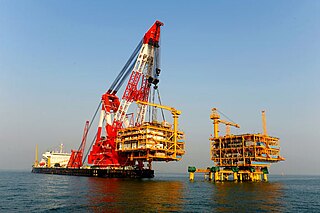
Lanjing (蓝鲸) is a self-propelled, deep water crane vessel, owned by China National Offshore Oil Corporation (CNOOC), the national oil exploration company of China, through its Hong Kong-listed subsidiary CNOOC Limited. Built in 2012, it is one of the six large crane barges owned by COOEC and CNOOC, namely HYSY201, HYSY 202, Lanjing, Blue Xinjiang, Binhai 109, HYSY286, HYSY289 and HYSY291.
Brunei Energy Services and Trading is an integrated energy company based in Bandar Seri Begawan, Brunei. Founded in 2002, it is completely owned by the Government of Brunei, and serves as the national oil and gas company. Until July 2020, it was known as Brunei National Petroleum Company and as PetroleumBRUNEI.
